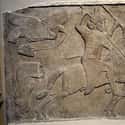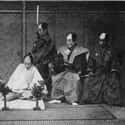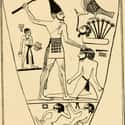-
(#2) Dismembered: The Chinese
One of the most powerful empires in Chinese history, the Shang Dynasty lasted for more than 500 years, and is the first recorded period in ancient Chinese history. It was also home to brutal techniques focused on ripping apart the bodies of those who were sacrificed.
Shang human sacrifice victims were burned, split into halves, beheaded, or chopped up. The most common ceremonies were pit, foundation, and interment sacrifices. For pit sacrifices, young men were ripped apart and buried without their possessions. Foundation sacrifices involved children and infants, while interment sacrifices focused on young women.
Some of the people sacrificed were captives, others criminals. The Shang also made sacrifices to various gods.
-
(#5) Fatal Blow To The Head: The Mesopotamians
Like the pharaohs of ancient Egypt, the royals of ancient Mesopotamia were buried with the rest of their household. This included some members of the royal court, such as soldiers, handmaidens, and servants. Human remains found at an archaeological site in Ur (now Iraq) attest to more than 2,000 people being sacrificed in this way.
In an innocent near-past, experts believed victims of sacrifices in Mesopotamia were poisoned peacefully before burial. Recent discoveries suggest a more brutal practice. Analysis of skeletal remains suggests that victims were struck in the head before burial. Some have speculated that targets may have been struck in the head to end them because the poison wasn't enough, thus preventing them from being buried alive. However, the truth about why they were dispatched in such a way remains unknown.
-
(#10) Honor Suicides: The Japanese
The Japanese practiced an honorary form of self-sacrifice called seppuku. Often referred to as hara-kiri in the West, the Japanese typically refer to it as seppuku. This practice was one of the many ritualized aspects of the life of samurai in feudal Japan. Samurai committed seppuku for a variety of reasons - as punishment for a crime, to restore their honor, or to show solidarity with a recently deceased lord.
The ritual had several steps. First, the warrior ate his favorite meal, dressed in his best robes, drank sake, and wrote, then recited, a death poem. Next, he thrust a dagger into the left side of his own abdomen (believed to release his spirit), drew the blade laterally to the right, and then turned the blade upward.
The end of the ceremony required an assistant, called a kaishakunin, to finish the sacrifice by decapitating the samurai.
-
(#9) Tossed Into Pits: The Mayans
The Mayans were a highly religious people known for hosting elaborate ceremonies. One of these ceremonies included the seemingly brutal practice of throwing human sacrifices into large limestone pits called cenotes, which typically had water at the bottom.
These huge, natural sinkholes were believed to be portals to the spiritual realm. Therefore, people were pushed into them as divine sacrifices.
-
(#4) Buried Alive: The Ancient Egyptians
In the golden age of ancient Egypt, pharaohs were buried with effigies of their retainers (servants and other followers), but pharaohs of the First Dynasty were buried with their actual, living retainers, in a practice known as retainer sacrifice.
These servants (and sometimes high-ranking officials) were sacrificed in accordance with religious beliefs. According to these beliefs, servants were meant to continue serving their rulers after they perished. Essentially, rulers were so important that they needed an entourage in the afterlife.
As the First Dynasty ended, retainers managed to convince pharaohs that they could better serve if left alive to continue carrying out the will of the pharaoh on Earth.
-
(#8) Mass Decapitation Of Slaves: The Dahomey
Xwetanu was an annual celebration in Dahomey, an ancient West African kingdom located in present-day Ghana. The ceremony consisted of many things, including the sacrifice of slaves to honor deceased kings. The preferred method of sacrifice was decapitation.
So many sacrificial victims were beheaded that the ceremony's name translates to "yearly head business." One source states that thousands of people were sacrificed under the leadership of one king.
New Random Displays Display All By Ranking
About This Tool
Human sacrifice is one of the ten most terrifying customs in the world. The ancients believed that everything was controlled by God. Therefore, people pray for the blessings of the gods through rituals and usually donate valuable things as tribute, and even live humans were as tributes to show piety in some places. For example, in Maya culture, there is a tradition of killing human beings as sacrifices, and the Maya's method of killing sacrifices is bloody and violent.
There were many types of sacrificial rituals in ancient society, and their ways changed according to time and region. Among the many sacrificial rituals, the cruelest is human sacrifice. The random tool introduced 11 details about different human sacrifice practices.
Our data comes from Ranker, If you want to participate in the ranking of items displayed on this page, please click here.
















